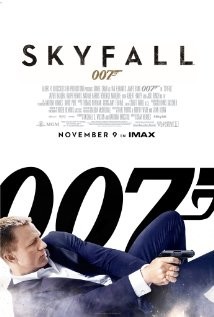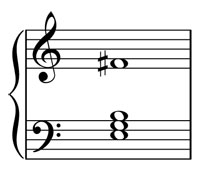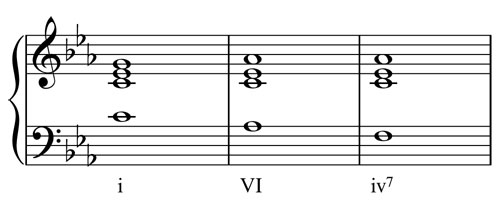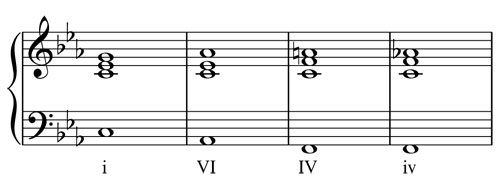This is the fourth in a series of six posts on the 2013 Oscar nominees for Best Original Score. After discussing each of the five nominees in separate posts, the sixth post will give my prediction for the Oscar winner and my reasoning behind it.
 Thomas Newman comes from a family with several film composers that began with Alfred Newman, who was the long-time head of the music department at 20th Century Fox and wrote for many films from Hollywood’s golden age in the 1930s and 40s. Thomas himself is a veteran of the industry, having scored dozens of films including Scent of a Woman, The Shawshank Redemption, American Beauty, Finding Nemo, and WALL-E. Although Newman has yet to win an Academy Award, he has been nominated ten times, most recently for his score to the 50th-anniversary James Bond film, Skyfall.
Thomas Newman comes from a family with several film composers that began with Alfred Newman, who was the long-time head of the music department at 20th Century Fox and wrote for many films from Hollywood’s golden age in the 1930s and 40s. Thomas himself is a veteran of the industry, having scored dozens of films including Scent of a Woman, The Shawshank Redemption, American Beauty, Finding Nemo, and WALL-E. Although Newman has yet to win an Academy Award, he has been nominated ten times, most recently for his score to the 50th-anniversary James Bond film, Skyfall.
With such a long-standing franchise, the creation of a Bond film poses unique challenges to all involved. On the one hand, it must uphold enough of the traditions for audiences to recognize the connection with previous installments. Yet on the other hand, it ought to introduce new elements as well in order to keep the series feeling fresh with each outing. The music is no exception, and Newman’s score for Skyfall is a combination of both the old and the new, as I demonstrate below in a film music analysis
Cross-Pollination of the “Skyfall” Song and the Score
Much praise has been lavished on the film’s title song both for Adele’s highly expressive performance and for the song itself—indeed, it has earned Adele and Paul Epworth an Oscar nomination for Best Original Song. But even though the song is not part of the film’s original score, it deserves mention because there is much cross-pollination between the music of the song and that of the film.
For instance, the song both begins and ends with a sustained version of the minor add-9 chord that begins the famous gun-barrel sequence in Bond films:
 This chord creates an instant connection with the music of the whole franchise and informs us that what we are about to hear is not just any song, but specifically a James Bond song.
This chord creates an instant connection with the music of the whole franchise and informs us that what we are about to hear is not just any song, but specifically a James Bond song.
The Bond sound, however, is worked into the “Skyfall” song in a more fundamental way. After the add-9 chord, we hear a repeated three-chord progression in C minor: i-VI-iv(7).
 At first, there is nothing strange about the progression as it is a fairly standard one in pop songs. But when the rest of the band enters with electric guitar, bass guitar, and percussion, the progression changes ever so slightly to i-VI-IV-iv. That is, the last chord is transformed into a major chord before returning to its original minor form:
At first, there is nothing strange about the progression as it is a fairly standard one in pop songs. But when the rest of the band enters with electric guitar, bass guitar, and percussion, the progression changes ever so slightly to i-VI-IV-iv. That is, the last chord is transformed into a major chord before returning to its original minor form:

This subtle change allows the guitar to sound the notes G-Ab-A-Ab in harmony with the progression, as shown in the top line of the example above. The resulting four-note motive is one of the most recognizable in Bond films. It’s the accompaniment figure we hear at the start of the gun-barrel sequence that slyly glides up and down chromatically, and which some have appropriately called the “suspense theme”. When this motive appears in Bond films, it is usually over an unchanging harmony (again, recall the gun-barrel sequence):

Hear it in the clip below:
In the “Skyfall” song, this theme is harmonized with a new set of chords, giving it a sound that is now associated with this specific song. In other words, it is as if the old suspense theme is given a new coat of musical paint, one that we can easily trace back to the title song.
Hear this new version of the theme in this clip from 0:59:
There are several scenes later in the film where Newman incorporates this version of the suspense theme:
- When Bond washes shrapnel from his shoulder and delivers it to MI6
- When M orders Bond to go to Shanghai
- When Bond receives new gadgets from Q (last note of theme omitted)
Also, when Bond enters the casino in Macau on a gondola, we hear an instrumental version of the song with its melody (from 0:14):
These techniques of blending old Bond themes with the title song and using that song in the original score are not unique to Skyfall—the same occurs in several other Bond films, notably Goldfinger. But because the song itself is new and because the song features the Bond suspense theme, it ensures that Newman’s Skyfall score will maintain continuity with previous films while at the same time adding something new.
The James Bond Theme
The James Bond theme is the familiar main theme for the Bond films that made its debut with the very first of the series, Dr. No. Composers for the Bond films often develop ideas from either its first section (with the famous guitar riff) or its more bebop middle section, shown below.

Hear it in this clip from 0:40:
The large leaps, chromatic “added” notes, and angular shape of this melody give it an energetic, suave, and jazzy sound. It is no surprise, then, that we usually hear it accompanying Bond doing something heroic in tense action scenes. In Skyfall, for example, the theme appears when:
- Bond is in the excavator on the train at beginning, deflecting bullets shot at him
- The helicopter convoy rescues him as a result of his using the mini-transmitter
- He enters the courthouse and saves M
- He’s setting the gas tanks to explode in the Skyfall house at the end
Newman therefore maintains this tradition of Bond films and retains a sense of the old within his score to Skyfall.
At the same time, Newman is not averse to developing the old Bond themes into slightly new shapes. Take the suspense theme, for example. In the spectacular motorcycle chase at the film’s opening, we hear this theme continue rising up instead of falling back down as it usually does. You can hear this in the clip below from 3:26:
Bond Themes with Old Bond-Film Scoring
In addition to using the musical themes of the previous Bond films, Newman also occasionally scores them with the same jazz-band instrumentation as in earlier films. This is particularly noticeable since the majority of Newman’s score is a mixture of synthesized and acoustic instruments typical of contemporary Hollywood scores. Listen to the first few seconds of the following clips and you’ll know what I mean:
Juxtaposed with this style, the jazz scoring really stands out. The very start of the film, for instance, gives the audience the two brass blasts that usually open the gun-barrel sequence at the beginning of Bond films. But even though that sequence is postponed to the tail end of Skyfall, the association remains strong enough that anyone familiar with other Bond films will recognize that these brass chords signal the beginning of a James Bond film.
When we finally do get the iconic gun-barrel sequence at the end of the film, it is heard in the jazz-band scoring of previous Bond films:
Incidentally, it should be noted that this sequence is not always scored in precisely the same way since the guitar’s low-pitched melody has been played by various instruments. As Jeff Smith points out in The Sounds of Commerce:
Often these small variations in the orchestration are done to accommodate more global patterns of instrumentation within the individual Bond score. The shrill and brassy sound of Goldfinger’s “Bond Is Back,” for example, is consistent with the brighter instrumental textures of the score as a whole. In contrast, A View to a Kill begins with a darker toned, more somber rendering of the Bond theme, one that conforms to the score’s overall emphasis on traditional orchestral forces, particularly the low brass and strings.
Within the film proper, the most prominent use of the old-style scoring occurs when Bond takes M to his Aston Martin and drives her to Scotland to flee from the villain Silva. The music begins as soon as M resigns herself to getting in the car. And what should we hear at this point? The James Bond theme, of course! The very same music as in the gun-barrel sequence. Its appearance here, in the ‘60s-style scoring, is the perfect accompaniment to the ‘60s Aston Martin that Bond was first given in the Goldfinger. Bond verbally emphasizes this connection with the past in this scene when M asks him where they are going, to which he replies, “Back in time. Somewhere where we’ll have the advantage.”
References to Hans Zimmer
Newman’s score is not limited to his own musical style, nor that of previous Bond films. In one scene, the score references Hans Zimmer’s Batman themes from the Dark Knight films (likely due to their use in the “temp track” – the temporary score heard with the film before the final score is written, composed of bits and pieces of pre-existing music). The scene in Skyfall shows Bond in Shanghai following Patrice, the man who made off with the all-important list containing the identities of undercover British agents. Patrice, on his way to carrying out an assassination, takes an elevator up a high-rise. Just as the elevator begins to ascend, Bond dashes over to it, leaps up, and hangs from its bottom, unnoticed by Patrice (in a glass elevator!). This heroic act is accompanied musically by two themes in D minor, Batman’s key in Zimmer’s Dark Knight scores. The first theme takes after a theme we hear near the start of The Dark Knight, and the second is a very close emulation of Batman’s “heroic” theme (see Part 1 of my Dark Knight posts), which sounds the progression i-VI, with the second chord being blasted out from the brass instruments. Newman even uses a very similar accompaniment to Zimmer’s repeating F-F-D-D pattern as a background for the themes. Compare the two below:
First theme of Zimmer’s quoted (from 0:10-0:19):
Second theme of Zimmer’s quoted:
Newman’s themes in Skyfall (from 0:00):
Why does the score (or why did the temp track) reference Zimmer in this particular scene? It likely has to do with the fact that Bond is ascending—or rising—while doing something heroic. The act of rising is a major component of The Dark Knight Rises, especially in a scene where Bruce Wayne climbs heroically out of a prison built inside a pit. In that scene, we hear the same “heroic” Batman theme (see Part 5 of those posts for a full discussion of the climbing scene). The Zimmer reference therefore occurs at a place in Skyfall that, at least in an abstract way, parallels the Dark Knight films through its images.
Coming soon—Dario Marianelli’s score for Anna Karenina.
Wonderful analysis (and I love your blog!). I’m curious if you have any thoughts on the quiet, brass-chorale style theme in Skyfall that I vaguely recall accompanying scenes of contemplation or mourning. Had a nice chromatic zing to it, typically Tom Newman-esque to my ears.
Keep up the great work!
-Frank
Thanks, Frank! Yes, this was a striking passage – you can hear it at the opening of the soundtrack cue “Voluntary Retirement”. There are two phrases, both repeated, and all the chords are third-related. The first phrase goes AbM – Abdim/Gb – EM, but when it’s repeated, the second chord becomes Abdim/F, lending the phrase a tinge of tragedy with the diminished seventh chord. The second phrase is only two chords, again third-related: C#M – EM, the repetition being the same this time. Interesting that third-related chords like these continue to have fresh sound even in the twenty-first century.
I also found the cue ‘Voluntary Retirement’ really interesting during the film. The movement of a third from the AbM (bypassing the Abdim/Gb as a passing chord) to the EM has maybe a parallel to the same chord movement in the main title from Goldfinger? An appropriation of existing Bond musical material?
Ah, very cool. Sure, I think that’s entirely plausible. Good catch, Tom!
I really admire your passionate and intricate attitude towards film scores. I please to forgive me my erroneous and untrained english. I can not speak about technical details of this score, but I would like to say something about Zimmer’s influences.
In my perspective all the references to the Zimmer’s Batman are not an intentional homage, it’s just a pathetic result of a “temp-track thinking”. I’m sure that such a inventive composer as Thomas Newman, is truly embarassed that those “rip-offs” are part of his score. I remember while watching the movie, just when “She’s mine” plays, I was thinking: “What exactly movie is that?! The Dark Knight or what?” then I burst out laughing… this is how the producers destroy a movie experience.
@jackjack – Yes, you’re right, the Zimmer reference could be a case of being forced to adhere to a temp track. If so, then I suppose someone else (probably the director) wanted to pay homage instead. It might not have been Newman’s idea. Good point!
And yes, I share the same feeling that it spoils some of the movie’s atmosphere in this case. I laughed too!
I’d have to say the Zimmer nod in Track 7 is intentional. Sam Mendes said that Nolan’s Batman trilogy was a heavy influence on Skyfall and the 007 does borrow a rather high number of plot points and devices from that superhero series. It *could* be a temp track thing but it is more than likely just one more bit of cross-pollination given that very little about the film is original unto its self.
Phenomenal site!! Really enjoying going through your analysis and learning quite a bit. Please keep up the fantastic work.
On the musical graphic below the text –
“The Bond sound, however, is worked into the “Skyfall” song in a more fundamental way. After the add-9 chord, we hear a repeated three-chord progression in C minor: i-VI-iv(7).”
– I think you may mean an A natural in the final chord, making the F7.
Thanks again for this insightful site!
Regards –
dan miller